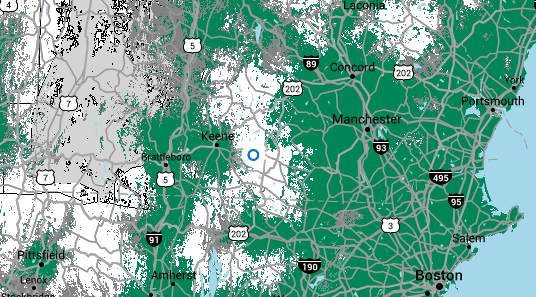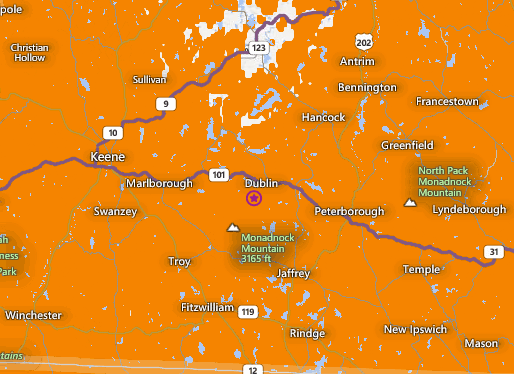These days the go-to solution for a Canadian traveling to the USA and needing a short-term prepaid SIM card for their mobile phone is Roam Mobility. They’re a Canadian company in the business of providing SIM cards to Canadians traveling in the US and Mexico. They’re flexible, cheap (compared the the high cost of roaming on your Canadian mobile account) and, in my experience, everything just works as it should.
Except if your travel to the US happens to be to southern New Hampshire and, specifically, to a Roam Mobility dead zone between Milford and Marlborough along Route 101, a dead zone that my client, Yankee Publishing, happens to be exactly in the middle of:

Roam Mobility doesn’t actually operate its own mobile network in the US, they resell service from T-Mobile, so it’s really a T-Mobile dead zone that they’re inheriting. But, regardless, it means that Roam Mobility is useless to me if I want to have mobile coverage while visiting Yankee.
Plan B, in my case, is based on a scheme well-documented by Dan James back in 2011 involving an AT&T GoPhone SIM.
AT&T’s coverage of southern New Hampshire is, in theory, much more complete and dead-zone-free than T-Mobile’s:

Armed with this knowledge, I stopped in at the Burlington Mall AT&T store (note that there are two in the mall and the upstairs one, by the food court, is smaller and less well-known so you might get quicker service there). I explained my situation to the helpful clerk there, and once she’d established that I knew exactly what I was looking for, she happily dispensed with any attempt to up-sell me to a lifetime mobile contract and a new phone. She went into the back room and emerged with a SIM, activated it while standing in front of me using a tablet, and I was up and ready to go. Before I left, she made sure I had service; we shook hands, and I was off.
I purchased $20 of credit on the SIM, and the SIM itself was free. I signed up for the “$2/day” plan, which debits $2 on any day in which I make a phone call or send a text (and debits nothing on days that I don’t). There’s a handy $1/day data package add-on that provides 100MB of data; it’s a little clunky because you have to sign up for it every day but that sign-up process is something that can be done on the phone itself, before signing up for the package; and the “day” lasts until midnight on the next day, so it’s effectively a 48 hour window (compared that to Virgin Mobile’s $20/100 MB US Travel Data Pass – 20 times the price for the same data).
I was in the US for 7 days, and when I left I still had $9 of my original $20 in credit. I consumed the $11 as:
- 5 days worth of $1/day data package for a total of $5.
- 3 days worth of $2/day voice/text for a total of $6.
I ran out of data once, somewhat inconveniently while using Waze to navigate in Massachusetts on Saturday, but I was able to pull over and top-up without issue.
The coverage in southern New Hampshire wasn’t quite as rosy as AT&T’s coverage map makes it out to be: I had no signal at all from the Jack Daniels Motor Inn in Peterborough, which was inconvenient as that’s one of the places I wanted to be able to receive calls and texts. And the coverage up the hill at Yankee was spotty: there was signal in some parts of the building and not others.
Otherwise, though, I had coverage throughout my trip, from Burlington across southern New Hampshire to Brattleboro, Vermont, down to Chicopee, Massachusetts, over to Hillsdale, New York and back through to Boston. I navigated using Waze and Google Maps. I used Google Now to control my phone in the car hands-free, a checked in on Foursquare, I updated Twitter and Instagram, I used Google Hangouts to talk to home. And I sent and received a couple of text messages.
Dan pointed out a few downsides of the AT&T GoPhone system in his original post:
- Topping up the account for Canadians was difficult: AT&T now points to prepaid.com directly from its own site as the solution to this. I didn’t need to use this, as I never extinguished my credit. I also found that AT&T top-up cards were for sale in almost every gas station and convenience store I stopped at while I was traveling.
- The SIM expires: depending on how much credit you purchase, the SIM will expire anywhere between 30 days (< $25 credit) to a year ($100+ credit). Once it expires, your telephone number expires with it. So in my case, unless I top the SIM up in the next 20 days, it will expire in late August and the next time I visit the USA I’ll need to go through the same SIM purchase process as though it was a new day.
The really good coverage in southern New Hampshire, my colleagues tell me, is from Verizon; unfortunately Verizon uses the older CDMA network which doesn’t work with my Canadian GSM phone, so I can’t take advantage of that.
All that being said, AT&T GoPhone proved an inexpensive, mostly-working way of staying online and in touch on this trip, and I’m likely to use the same solution again when I return in the autumn.
 I am
I am
Comments
I used Airvoice for about a
I used Airvoice for about a year, which used to sell 3G connectivity on the AT&T network at a cut-rate. Might be worth comparing, I suppose. I had a good experience with it.
Add new comment